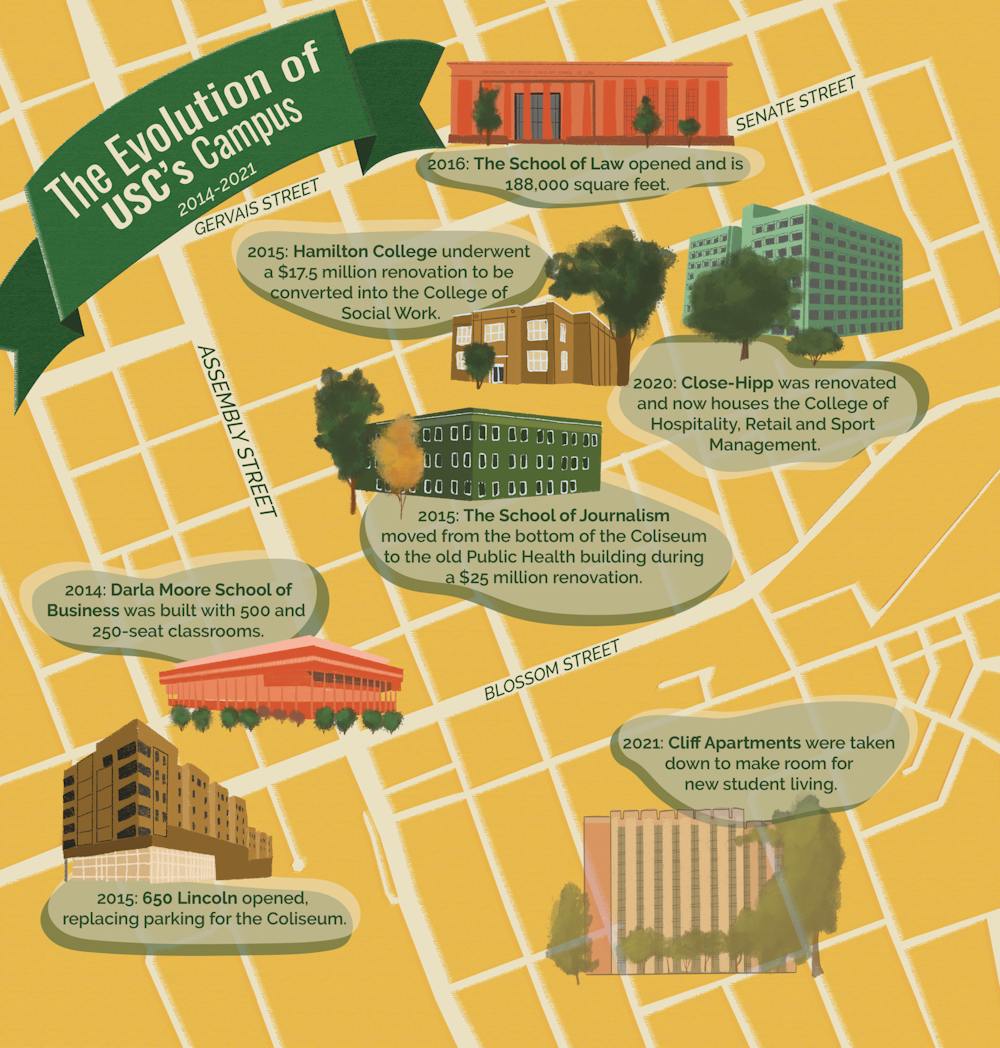In the past 220 years of USC’s existence, the university has grown from the surrounding Horseshoe area to include much of Columbia. It continues to expand with new projects such as Campus Village and the health sciences campus.
USC released a master plan update in 2018, which included all of the projects completed since the previous master plan in 2010 and plans for future renovations and expansions.
Since the previous plan, USC most notably built the Darla Moore School of Business in 2014, 650 Lincoln in 2015, the USC School of Law in 2016 and the Center for Health and Well-Being in 2017.
With the addition of these new buildings and the future addition of Campus Village and the health sciences campus, USC will continue to change and grow. As USC continues to expand, there have been concerns over the communities that were destroyed in the process.
In the '60s and '70s, when USC moved south into the area where the Carolina Coliseum, Strom Thurmond Wellness and Fitness Center and 650 Lincoln are located, it demolished a neighborhood called Ward One. Ward One was a historically Black community that was pushed out under urban renewal.
“Through an urban renewal campaign of the '60s, those areas were acquired using eminent domain methods, arguing that the acquisition of these properties were in the interest — was in the public interest, meaning the interest of the university,” Bobby Donaldson, associate professor of history, said. “That led to a dramatic redevelopment of the campus at the expense of these African American families and institutions.”
Other neighborhoods, such as Wheeler Hill, where Campus Village is currently being built, and University Hills, where Capstone, Gambrell and the humanities buildings exist, have been changed in a similar way.
“It's happening all the time in our campus — our university is growing every day,” Donaldson said. “And so, to grow, they're going to have to figure out ways to expand their footprint in an urban environment. And so, it does mean you rethink about repurposing space at the Bull Street mental facility. It means you think about student housing.”
In the past several years, other projects have included renovations to several facilities, such as Women’s Quad, South Tower and Patterson. In 2015, Hamilton College underwent renovations to become the College of Social Work, and the old school of public health was renovated to become the School of Journalism and Mass Communications.
More recently, Close-Hipp was renovated in 2020 to become the College of Hospitality, Retail, and Sport Management. Another project included renovating the brick wall that surrounds parts of USC’s campus.
“They actually built it to try to keep the students on campus,” Elizabeth West, university archivist at South Caroliniana Library, said. “Because in 1835, the students were not allowed to leave campus without permission from the faculty or the president. And they had a bad habit of sneaking into town at night and going to the bars and taverns and coming back and causing a bit of trouble.”
In 1865, when Sherman marched to the sea, he burned much of Columbia. The Horseshoe and many of the buildings on it survived because of the wall running along Sumter, Pendleton and Greene Streets.
“There’s an eyewitness account that describes the flames sweeping up to the very wall of the campus,” West said.
The 2018 plan also highlighted several future projects the university has in the works. Campus Village, the engineering district and the health sciences campus are among those. As a part of Campus Village, Cliff Apartments was torn down this year.
According to communications manager Koby Padgett, construction on the site of Campus Village, which will include four housing residencies and a transportation hub, will begin summer 2021.
In a board meeting on March 14, the board of trustees approved phase one of relocating the medical school to the health sciences campus at the BullStreet District. The first phase includes $4.2 million in costs, and construction is scheduled to begin in 2024.
With these new construction projects underway, USC needs to think about the communities it will impact, Donaldson said.
“The other thing I think the university needs to do and should do and is doing, to some degree, is listening — listening to citizens and to residents and taking into consideration their own thoughts about how to acknowledge a neighborhood that will not look the same as it did 50 years ago,” Donaldson said.

